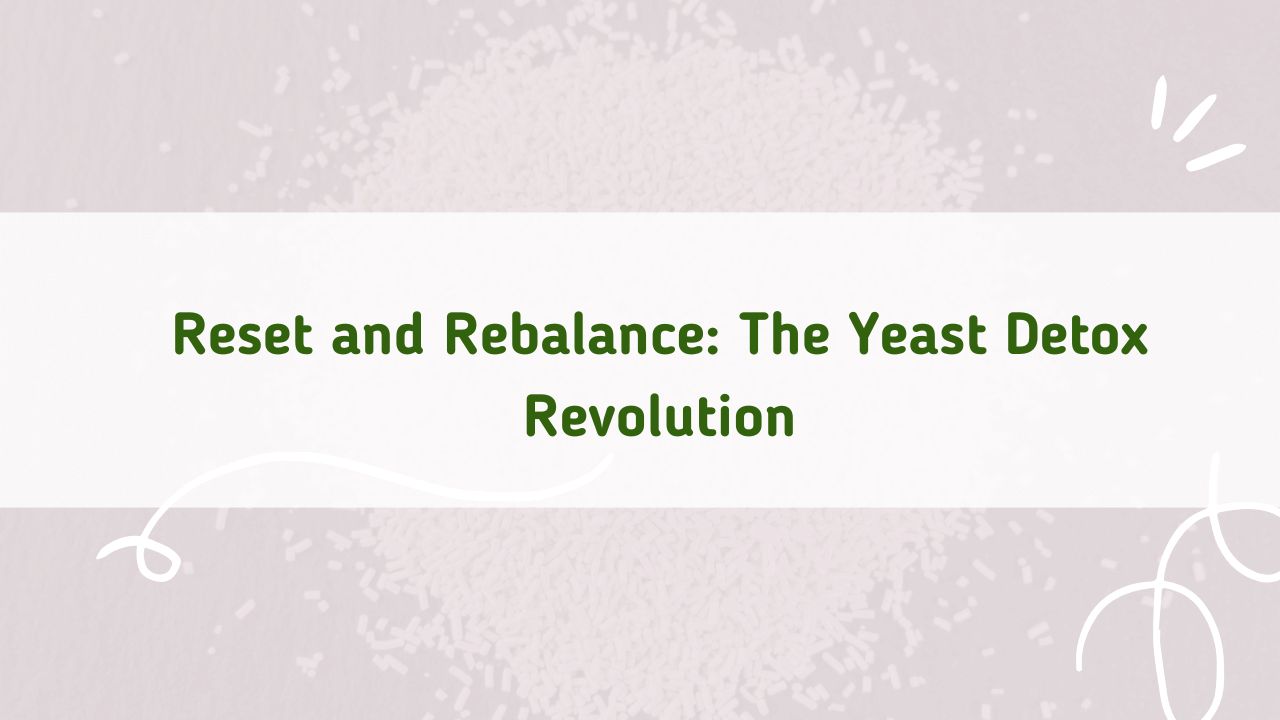Yeast Detox 101: Strategies for Overcoming Fungal Imbalances

Unbeknownst to many, yeast overgrowth is a prevalent issue that affects our health and well-being. Predominantly caused by Candida albicans, a fungus inhabiting our digestive tract, yeast overgrowth can lead to many health problems. Fortunately, yeast detox, also known as a Candida cleanse, can address this issue. But what exactly is yeast detox? Let’s dive deeper.
Contents
- 1 Candida Overgrowth: When Our Natural Balance is Disturbed
- 2 A Road to Recovery: The Candida Diet and Yeast Detox
- 3 Supplements and Superfoods: Adding Punch to Your Candida Cleanse Diet
- 4 The Role of Apple Cider Vinegar in Yeast Detox
- 5 Not Just Food: The Holistic Approach to Yeast Detox
- 6 Addressing Doubts: The Scientific Evidence
- 7 Quinoa and Celery Meatballs
- 8 Cassava Soup
- 9 The Journey Towards a Candida-Free Life
- 10 FAQ
Candida Overgrowth: When Our Natural Balance is Disturbed
To understand yeast detox, we must first examine the culprit – Candida. This fungus is a typical resident of our gastrointestinal tract, living in harmony with other microorganisms in our gut microbiome. However, certain risk factors can trigger an overgrowth, leading to conditions like oral thrush and more severe forms called candidiasis, such as invasive candidiasis.
A weakened immune system, high intake of processed foods and simple sugars, long-term use of antibiotics, and stress are some factors promoting Candida overgrowth. Symptoms often include brain fog, joint pain, and infections. These can appear as oral thrush or vaginal yeast infections, but other symptoms like fatigue, bloating, and mood swings may be less noticeable.
A Road to Recovery: The Candida Diet and Yeast Detox
Addressing Candida overgrowth involves dietary changes, supplement regimens, and lifestyle modifications. At the center is the Candida cleanse diet, which focuses on whole foods and eliminates sugar, alcohol, and refined carbohydrates – the primary fuel for yeast growth.
The Candida diet emphasizes eating healthy protein, healthy fats, non-starchy vegetables, and some healthy carbs. Dark leafy greens like Brussels sprouts, other cruciferous vegetables, and food groups like lean meats, fish, and eggs are recommended. Foods like bone broth can boost the immune system, while coconut and olive oil, rich in anti-inflammatory properties, aid in nutrient absorption and health.
Supplements and Superfoods: Adding Punch to Your Candida Cleanse Diet
Apart from the diet, several supplements can aid in the battle against candida infection. Caprylic acid, a fatty acid found in coconut oil, is known to have potent antifungal properties against Candida. Similarly, when used as essential oils, clove, and tea tree oil have shown promise in combating yeast infections.
Even certain food groups can be considered superfoods in this context. For instance, sunflower seeds are a fantastic source of ascorbic acid (Vitamin C), a vital nutrient that boosts the immune system and promotes health.
The Role of Apple Cider Vinegar in Yeast Detox
One household name in the Candida Cleanse arsenal is apple cider vinegar. As research suggests, its antifungal properties can potentially hinder the growth of Candida yeast cells. Including a tablespoon or two in your diet can benefit those looking to perform a yeast cleanse.
Not Just Food: The Holistic Approach to Yeast Detox
While dietary modifications form the core of a yeast detox, they must be complemented by a holistic approach to lifestyle modifications. This includes adequate sleep, stress management, and regular physical exercise—all crucial in enhancing your immune system.
Remember, a yeast detox is not an overnight miracle. It’s a journey that takes a few weeks if not months. Ensure you document your symptoms and work closely with a healthcare provider to ensure a safe and effective detox process.
Addressing Doubts: The Scientific Evidence
As with any diet, the Candida cleanses diet has its critics. The diet is quite strict, and some may struggle to stick with it. Moreover, it’s worth noting that the diet’s effectiveness against systemic candidiasis lacks robust scientific evidence.
However, many who have followed this diet report experiencing relief from symptoms, reduced yeast infections, and improved health. While further research is needed to validate these claims fully, the anecdotal evidence indicates potential benefits.
Quinoa and Celery Meatballs

Ingredients:
- 1/3 cup dried quinoa
- 1/4 medium head of celery
- 1 onion
- 8-inch long leek
- 1 clove of garlic
- 1/4 cup parsley
- 1 small hot red pepper
- 2 eggs, lightly beaten
- 1/2 tsp turmeric
- 1/2 tsp salt
- 1/4 tsp paprika
- 2 tbsp olive oil
Directions:
Step-1
Preheat oven to 400 degrees F.
Step-2
Cook the quinoa according to the package directions. Finely chop the onion, leek, and red hot pepper. Chop the parsley and garlic. Lightly beat the eggs. Grate the celery.
Step-3
Mix the grated celery, onion, leek, parsley, garlic, egg, and seasonings in a large bowl.
Step-4
Grease the baking tray with olive oil. Form the meatballs into balls and place them on the tray. Bake for 25 minutes, removing occasionally and turning the other side.
For serving: You may dress it with sunflower seeds or a yogurt sauce and serve it with mixed dark leafy greens.
A vibrant, protein-packed treat, these Quinoa and Celery Meatballs are more than just a delicious meal. Quinoa, a complete protein, contains all nine essential amino acids our bodies can’t produce independently. Additionally, celery brings in a splash of antioxidants, including Vitamin C and beta carotene, supporting immune health.
Our zingy little friend, red pepper, punches up the flavor and adds a dose of Vitamin A, crucial for healthy vision. The turmeric and paprika do more than tickle your taste buds; they’re potent anti-inflammatories too! Lastly, eggs and olive oil are rich in nutritious fats – essential for nutrient absorption. Serve these up, and you have a tasty, nutritious powerhouse!
Cassava Soup

Ingredients:
- 1/2 cassava
- 1/2 potato (medium)
- 1 celery stalk
- 1/2 onion (medium)
- 1 clove of garlic
- 1 medium carrot
- 1 tbsp apple cider vinegar
- 2 cups of water
- Pepper and salt to taste
Directions:
Step-1
The first step is to dice up the cassava and the potato. The celery, carrot, and onion should be diced. Chop the garlic into small pieces.
Step-2
Place the cassava in a pot and cover it with boiling water. The cassava should be cooked for around 15 minutes or until tender.
Step-3
Place the potatoes in a big saucepan and cover them with boiling water.
Step-4
After the potatoes and cassava are cooked, add two more cups of water, then put in other veggies, apple cider vinegar, and chopped garlic.
Step-5
Continue cooking for another ten minutes. Do a taste test to see whether the veggies are ready.
Step-6
When the last of the soup is ready, turn off the heat. Season with salt and pepper, then serve up while still hot.
This hearty Cassava Soup is a bowlful of gut health. Starting with Cassava, a root vegetable that’s a substantial source of resistant starch – a prebiotic that helps nurture your gut microbiome. Potatoes, another resistant starch source, team up with cassava to create a satiating base. Celery, a low-calorie hydrating vegetable, is packed with dietary fiber, which aids in maintaining a healthy digestive tract. Carrots add a dash of beta carotene, which our bodies convert into Vitamin A, promoting good vision. The apple cider vinegar’s acidity can help boost your stomach’s digestion process by reducing stomach acidity. Together, these ingredients work harmoniously to serve you a delicious soup that doubles as a tonic for your digestive system. So, slurp away, and let this soothing soup nourish you from the inside out!
The Journey Towards a Candida-Free Life
A yeast detox is not a quick fix but a gradual process. Most noticeable improvements come after a few weeks of dietary changes, but everyone’s experience varies. It is essential to consult your healthcare provider before starting a yeast detox, especially if you are experiencing symptoms of Candida overgrowth.
In conclusion, maintaining a balanced diet high in whole foods, low in sugar, and abundant in healthy fats and protein can help manage Candida overgrowth. By following the Candida diet guidelines and incorporating beneficial practices like consuming apple cider vinegar, you can successfully navigate the path to yeast detox and a healthier you.
Remember, while yeast detox can help restore balance in your gut, it’s only a piece of the puzzle. It’s about lifestyle changes, stress management, adequate sleep, and regular exercise. Maintaining a healthy lifestyle and diet can provide long-term solutions, not only to Candida’s overgrowth but also to her overall well-being.
Your health journey may be challenging, but remember, every step you take towards improving your gut is a stride towards a healthier, happier you.
FAQ
1. What is a yeast detox, and how does it help my body?
A yeast detox, often called a candida cleanse, is a dietary approach designed to reduce the overgrowth of Candida albicans—a type of yeast—in your body. This overgrowth can lead to various symptoms, such as fatigue, digestive issues, and brain fog.
The detox process involves cutting out foods that feed candida (like simple sugars and processed foods) and incorporating nutrient-dense, immune-boosting foods instead. By doing this, you starve the candida, discourage its growth, and support the human body’s natural defense mechanisms. The result? A happier, healthier gut and a better overall sense of well-being.
2. How can I tell if I have candida overgrowth, and what are the common symptoms?
Recognizing candida overgrowth can be tricky, as the symptoms can mimic other health conditions. However, common symptoms include persistent fatigue, digestive issues (like bloating, constipation, or diarrhea), recurring yeast infections, skin and nail fungal infections, and even mood swings. Some individuals might experience brain fog and difficulty concentrating.
These symptoms are your body’s way of waving a red flag that something’s off balance in your gut. Remember, it’s always best to consult with a healthcare provider if you’re experiencing persistent health issues.
3. How long does a yeast detox or candida cleanse take, and when can I expect results?
The duration of a yeast detox or candida can vary depending on individual factors, such as the extent of the candida overgrowth and your body’s response to the diet. On average, it might take a few weeks to several months to see a significant improvement. Patience is key. It’s like taking a long, scenic road trip toward better gut health. You’re not just battling intestinal candida overgrowth; you’re fortifying your overall health, boosting your immune system, and nurturing your gut. So buckle up, and enjoy the journey towards better health.

Zeynep is a Dietitian and holds B.S. in Nutrition and Dietetics. She has a wide range of experience with patients, particularly in alternative medicine, oncology nutrition, hospital dietitian, neurological disease, and bariatric field.






